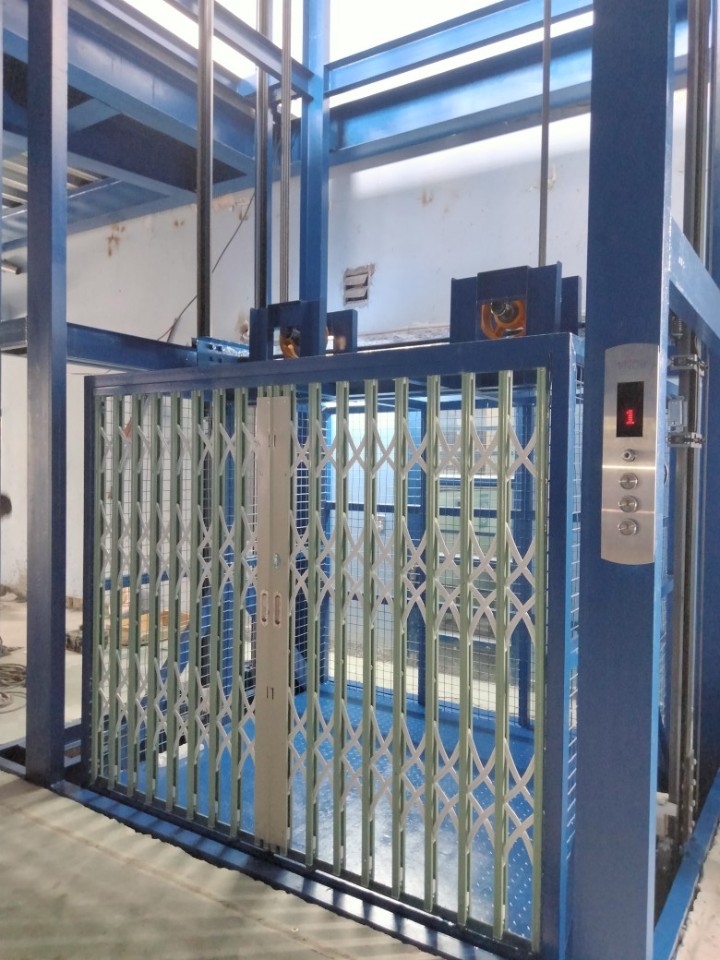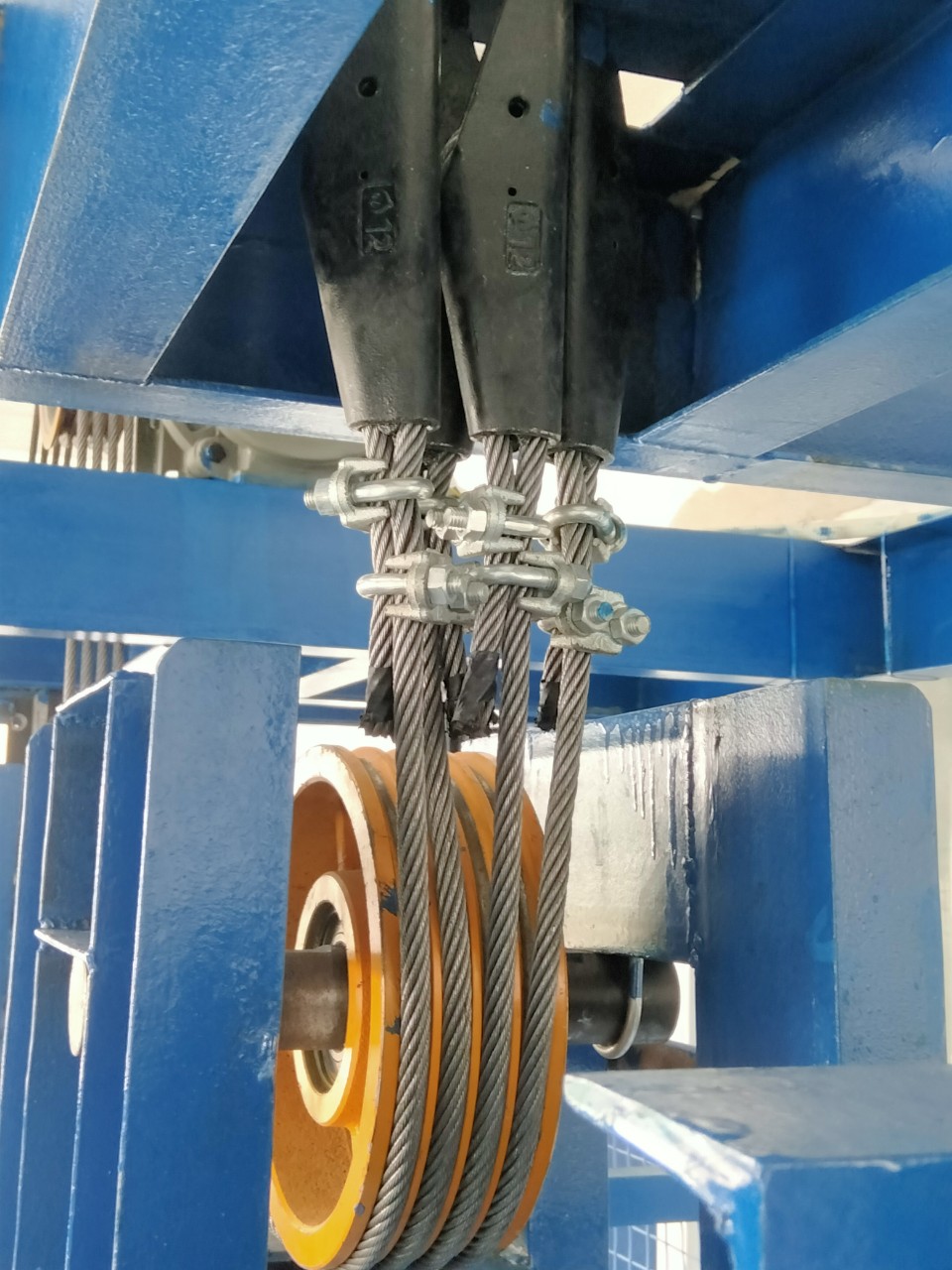What is an industrial cargo lift?
Vlift Cargo Lift, Industrial Cargo Lift is considered an indispensable device for factories, enterprises, and industrial zones. It is often referred to as an essential backbone. These lifts help ensure a stable and smooth production process.
Why does this machine possess such impressive capabilities? What is an industrial cargo lift? What are the advantages of freight elevators, and who benefits from them?
Let's explore industrial cargo lifts now
What is an cargo lift?
Cargo lift is a device used to transport goods between floors inside a modern warehouse. This type of elevator moves along fixed rails, distinguishing it from scissor lift models.
Simple design, easy operation. This is an industrial elevator commonly used in warehouses such as shopping centers, supermarkets, etc. When in operation, the industrial elevator moves on fixed rails in a vertical direction within the allowable operating limits.
Structure of the Industrial Cargo Lift
Basically, the cargo lift has four main components. These are the elevator pit and machine room, the elevator shaft, and finally, the electromechanical equipment for the elevator.
1. Elevator Shaft
This part has a height approximately equal to the height of the building and extends seamlessly from top to bottom. No machine room is required because the elevator operates without the need for a dedicated room. If there is a possibility of a machine room, that area would be located at the top of the shaft. In contrast to the machine room, the shaft is located at the very bottom of the building, beneath the lowest floor.
2. Electromechanical Components of the Elevator
These are further divided into smaller components. When people think about the structure of an elevator, they typically consider these parts rather than the elevator pit, pit shaft, or machine room. Through this article, you will understand that an elevator's structure includes more than just these components. To avoid keeping you waiting any longer, here are some basic features of the electrical and mechanical parts of a hydraulic freight elevator.
3. Guiding Rails
The components are installed throughout the entire shaft. They are responsible for guiding the elevator cabin as well as the counterweight in the vertical direction of the shaft. This is a crucial element in the process of raising and lowering the elevator.
4. Other Important Components
-
Counterweight and Elevator Cabin: The cabin is used to transport goods, often with people inside. The counterweight moves in the opposite direction of the cabin and can move up or down when there are no goods or people inside.
-
Control Cabinet: The elevator control cabinet includes many pre-programmed electrical and electronic components designed to ensure the elevator operates according to the user’s instructions.
-
Traction Machine: The traction machine is placed at the top of the shaft and is connected to the cabin and counterweight via cables. It affects the speed of the elevator's movement as well as its stability and durability during operation.
-
Cabin Door and Floor Door: These doors open and close every time the elevator reaches its designated floor, providing the highest level of security.
What are the advantages of industrial lifts?
Below are the benefits of industrial goods lifts in human life:
- With careful technical calculations, they are specially designed to ensure the equipment operates safely and efficiently.
- The industrial lift control system is equipped with anti-fall technology, interlocking lock technology on the doors at the upper and lower floors, and operation buttons that can be placed on any floor and on the lift itself, providing multi-point control.
- The product structure is solid, with a large load-bearing capacity. It operates quietly, with stable lifting and lowering, and is easy to maintain and install.
- Low energy consumption. The industrial elevator is energy-efficient, regulated by a smart electrical cabinet system.
- Low failure rate due to the use of advanced technology in industrial lifts, with good control modes ensuring high reliability.
- Quick installation (within one week at the site). It requires no large space, has a high density, and does not require a pit. Only simple operation and maintenance are needed.
What are the disadvantages of industrial freight elevators?
- The number of floors is limited, suitable only for workshops or residential buildings with 2-5 floors.
- The speed is not as fast or stable as passenger elevators.
- In addition to the above components, the design of industrial freight elevators may include automatic security features or speed limiters, depending on the type of elevator and its intended use. If you have any questions about industrial freight elevators or need assistance in purchasing a product, please contact us for more accurate support.
Things You Should Keep in Mind!
For those in the manufacturing industry, the goods lift is a familiar companion, playing a crucial role throughout the production process. However, very few people fully understand the characteristics of a goods lift. The following article will help you learn the basic features you need to know about a goods lift!
1. Basic Things About Goods Lifts, Cargo lift:
A cargo lift is a special lift used for transporting goods between different floors. Its important role helps minimize transport time between floors, making it a key link in the transportation and production chain in businesses.
A goods lift is typically made from sturdy materials such as stainless steel, iron, or stainless steel. With a powerful motor and a spacious cargo compartment, it is also equipped with a safety alarm system. A goods lift is a reliable transportation device.
2. Goods Lifts Are Not for Carrying People:
This is a feature to compare and distinguish between a cargo lift and an elevator. Although it is designed to be sturdy, made of stainless steel, iron, or steel, and equipped with an automatic bell system, a cargo lift is solely intended for transporting goods. Due to its specific purpose, using a cargo lift to transport people does not guarantee safety for the users.
Therefore, to avoid unnecessary risks, cargo lifts are not allowed to be used for transporting people. This recommendation will be directly advised and reminded by staff at the VNDB cargo lift design and installation company during the consultation and installation process.
3. There are many different types of freight elevators depending on the needs of the user
Don't think that cargo lifts are only used in factories, large industrial zones, or manufacturing plants! Cargo lifts can be used in many different ways, with various sizes and capacities, serving a wide range of needs.
There are different types of cargo lifts, such as hydraulic cargo lifts, lifts with capacities of 50-100kg, 150-200kg, or even 300kg, 500kg, 1 ton, 2 tons, and 5 tons. With such diverse designs, cargo lifts can be widely used by businesses of all sizes, from large enterprises to small and medium-sized businesses.
For example, households running multi-story businesses can use cargo lifts to transport goods between floors, or restaurants can also use them in a similar way.
So how can you know which type of lift is suitable for your business model and size? Simply contact the VNDB company's hotline – which specializes in manufacturing, constructing, and installing cargo lifts – and you will receive thorough and detailed advice.
4. Regular inspection and maintenance of the cargo lift are required to increase the product's lifespan!
This is essential if you want to use the lifting system for a longer time. No matter how well-designed or powerful the lifting system is, over time it can experience wear and tear.
If not properly maintained, the machinery will be affected, leading to weaker motor performance, reduced efficiency, and lower output. Not only that, but it could also result in unnecessary risks.
Regularly check and clean the lifting system, and contact the VNDB team for maintenance every two years to ensure the longevity of your lifting system.
5. Lifting equipment helps business owners save costs:
A cargo lift can help businesses save a lot of costs, and not only that, it also promotes profit growth. It’s hard to believe, right?
With its extraordinary lifting capacity that no worker can match, a cargo lift system can transport goods up to 10 times the amount a regular worker can in one day. At the same time, the cargo lift can operate at full capacity 24/7 with just one operator.
For this reason, a cargo lift can help businesses save time, increase productivity and output, boost profits, and reduce unnecessary labor costs.
The cost to install a cargo lift is not cheap, but if businesses compare it with expenses for human resources, such as wages, insurance, and benefits, and compare the output between using a cargo lift for transportation instead of manual labor, business owners can easily see how much the cargo lift helps the company save in costs.











Xem thêm